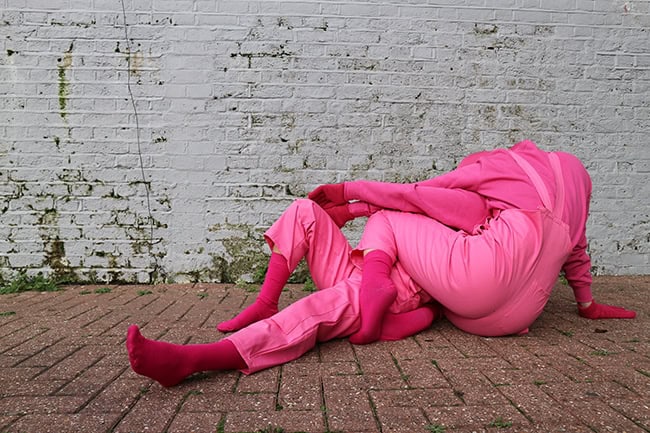Unbaptised Infants: TRACKS at SET Bermondsey
Posted: January 3rd, 2020 | Author: Nicholas Minns & Caterina Albano | Filed under: Concept, Performance | Tags: Emmett Williams, Hannah Parsons, Joe Garbett, Lorea Burge, Lorea Burge Badiola, Unbaptised Infants | Comments Off on Unbaptised Infants: TRACKS at SET BermondseyUnbaptised Infants, TRACKS at Bermondsey’s SET, December 14

Every now and then a performance comes along that stands out for its originality and integrity; the choreographic and musical material formed into TRACKS by Lorea Burge and Hannah Parsons of Unbaptised Infants, is one. It takes place at SET Bermondsey, site of a former paint factory, that has the air of a counter-culture space; an assortment of chairs, cushions and wooden benches define a concrete performance area with a speaker in each corner, and a couple of microphones with a loop station at the front. Behind the audience are a couple of tables, one displaying explanatory material for the performance — from handwritten poems in notebooks to copied pages from a book on the poet Emmett Williams — and the other a bar: tea before the performance and mulled wine after.
Since February Burge and Parsons have been preparing material for their ‘album’, which is the kind of gestation period a band might have; because of funding constraints, small-scale dance works are often completed in two weeks, but Unbaptised Infants is entirely self-funded. Without suggesting this route to creative endeavour is sustainable, it bravely and resolutely affirms the artist’s need for time in order to explore new ideas and to bring them to fruition rather than being boxed in by a funding schedule. The venue’s guardianship scheme also helps. ‘SET is a multifaceted arts and community initiative based in numerous centres across London, curating an eclectic and experimental arts programme alongside affordable artist workspace…in otherwise vacant property, some temporary and some long term.’ Burge and Parsons plan to tour TRACKS to similar alternative spaces for which their growing archive of material can be adapted.
Both artists have worked with Joe Garbett, another choreographer with a wealth of non-conformist ideas and an ability to translate them into sophisticated, pared-back, idiosyncratic work. The qualities that unite them all are intelligence and wit, and a knack of digging down into the infinite potential of human creativity and coming up with something that makes you scratch your head in admiration. Their work is an antidote to choreographic complacency, and in an era where grants are hard to come by, they take nothing for granted.
The birth of TRACKS began in creative limbo in 2015, when Burge and Parsons began to write poems under the spell of the poet Emmett Williams. This led to experiments in movement and sound, using the rhythms and intonations of poetry to influence movement and the substitution of notes for words to make songs. In addition to being ‘passionate about rhythm and in complicating things’, Burge and Parsons then appropriated rituals and laments in their research with the aim of evoking ‘catharses of joy, of celebration, and commonly, just rituals of getting on with things, finding ways to create momentum.’ As Burge notes grimly at the beginning, the element of lament has taken on a new significance following the recent election; TRACKS is a concept album that has arrived at the very moment for which its creative inspiration and resilience are most needed.
Employing an economy of means consistent with the times, there is no musical accompaniment that is not created in situ by the voices of the two performers, either spoken, sung a capella or processed through a loop station; costumes are also minimal: fuschia tracksuit tops under matching dungarees. The ten tracks cover various permutations of poetry, song and movement presented with a sense of lightness that belies not only the increasing complexity of formal interactions but the precarious political underpinnings of the venture. Burge and Parsons present the first half of the album as a selection of short tracks on the theme of community and creative resistance. In Nearness, they roll together from opposite corners of the stage to form an interconnected, interdependent sculptural entity from which emerge vocal harmonies that join and collide, merge and diverge in shades of light and dark before they roll back to where they started. Melody Free has an austere, almost monastic a capella quality, while the third track is a poem, Request, that is as bright as it is surreal; Chance Dance is a unison duet that is both earthy and uplifting. The second half of the album develops the same themes with increasing poetic, musical and choreographic complexity; we are drawn into this odd universe and find ourselves marvelling at its craft. It doesn’t take much to unite us at the end, circled around the stage, to sing the refrain of an earlier song, Why Oh Why?